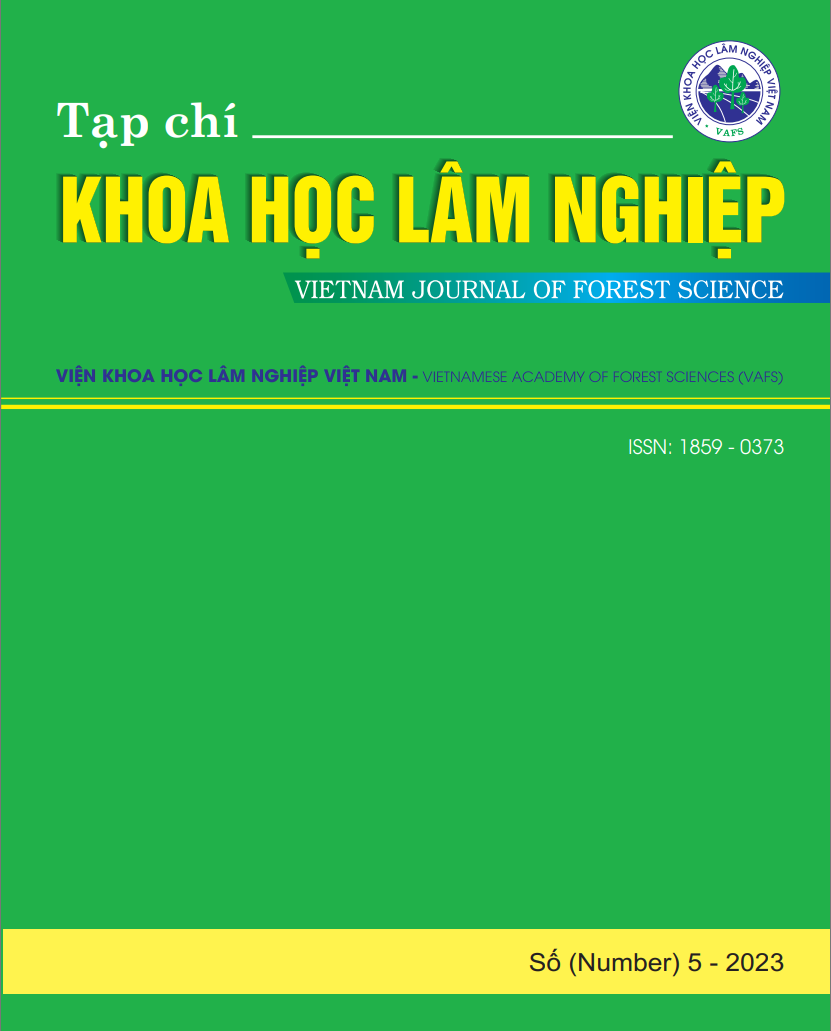THE EFFECT OF THE PRESSING PARAMETERS ON PHYSICAL AND MECHANICAL PROPERTIES OF PLYWOOD USING CASHEW NUTSHELL OIL ADHESIVE AS A GOOD GLUE
Keywords:
Cashew nutshell oil adhesive, plywood, adhesive, mechanical and physical propertiesAbstract
This article presents the results of a study on the effects of the pressing temperatures and times on the main physical and mechanical properties of Acacia mangium plywood using cashew nutshell oil glue as a binder. The plywood was made of Acacia mangium peeled veneers and cashew nut shell oil glue with a glue spread rate of 120 g/m2. The pressing temperatures of 110oC, 120oC and 125oC, and the pressing times of 13, 15 and 17 minutes were used in the experiments. The pressure of 1.1 MPa was consistent for all the experiments. Results showed that there was an insignificant difference in the densities of the plywood samples, while thickness swelling, MOR, MOE and bonding quality had a significant difference between the pressing parameters. The mechanical and physical properties of the plywood was best at the following parameters: the pressing temperature: 125oC; the pressing time: 15 minutes; the pressure: 1.1 MPa. The properties of the plywood were similar to the controlled plywood using UF adhesive of class 3 (plywood used in high humidity/exterior conditions), the plywood met the requirements of the standard ASTM D3043-17 and TCVN 8328-2.
References
1. Bùi Văn Ái, 2017. Hoàn thiện công nghệ sản xuất sơn chống hà biển cho tàu thuyền gỗ. Tạp chí Khoa học công nghệ Nông nghiệp và PTNT.
2. Australian/New Zealand standard, 2012. AS/NZS 2269.0:2012 Plywood - Structural - Part 0: Specifications. Aust Zeal Stand.
3. Thida Cho, Khin May Lwin, Su Myint Than, 2009. Study on the Production of Wood Adhesive from Cashew Nut Shell Oil. Leaflet No. 3/2009. Forest Research Institute, Forest Department, Ministry of Forestry.
4. Trịnh Văn Dũng, 2006. Nghiên cứu công nghệ sản xuất bột má phanh (bột ma sát) từ dầu vỏ hạt điều, Tạp chí phát triển Khoa học công nghệ 2007.
5. Tiêu chuẩn Việt Nam, 2014. TCVN 5694:2014 (ISO 9427:2003) Ván gỗ nhân tạo - Xác định độ trương nở khi ngâm trong nước.
6. Tiêu chuẩn Việt Nam, 2015. TCVN 10316:2015 Ván bóc.
7. Tiêu chuẩn Việt Nam, 2017. TCVN 11903:2017 Ván gỗ nhân tạo- Lấy mẫu và cắt mẫu thử nghiệm.
8. Tiêu chuẩn Việt Nam, 2018. TCVN 12445:2018 (ISO 16983:2003) Ván gỗ nhân tạo - Xác định độ trương nở chiều dày sau khi ngâm trong nước.
9. Tiêu chuẩn Việt Nam, 2018. TCVN 12446:2018 (ISO 16978:2003) Ván gỗ nhân tạo - Xác định mô đun đàn hồi khi uốn tĩnh và độ bền uốn tĩnh.
10. Tiêu chuẩn Việt Nam, 2010. TCVN 8328-1:2020 (ISO 12466-1:2007) Ván gỗ dán - Chất lượng dán dính - Phần 1: Phương pháp thử.
11. Tiêu chuẩn Việt Nam, 2010. TCVN 8328-2:2010 (ISO 12466-2:2007 Ván gỗ dán - Chất lượng dán dính - Phần 2: Các yêu cầu.
12. Ứng dụng khoa học và công nghệ để sản xuất keo nhiệt rắn MUF-E1 .M13 chất lượng cao dùng cho sản xuất ván gỗ dán đáp ứng nhu cầu xuất khẩu trên địa bàn tỉnh Bắc Giang
13. Nguyễn Thị Thuận, 2021. Công nghệ biến tính keo UF (Urea formaldehyde) bằng PVA (polyvinyl alcohol) dùng để sản xuất ván dán. Luận án tiến sĩ kỹ thuật. Đại học Lâm nghiệp
14. Nguyễn Đức Thành, 2021. Nghiên cứu tạo ván dán bằng chất kết dính có nguồn gốc sinh học từ axit citric và sucrose. Đề tài tiềm năng cấp Bộ NN & PTNT.
15. Nguyễn Thị Trịnh, 2023. Đánh giá bước đầu kết quả tạo keo dán chịu nước thân thiện với môi trường từ dầu vỏ hạt điều, Kỷ yếu hội thảo khoa học, công nghệ và đổi mới sáng tạo phục vụ phát triển kinh tế - xã hội nhanh và bền vững vùng Nam Trung Bộ - Tây Nguyên năm 2023.
16. Sukma SK, 2017. Development of particleboard made from sweet sorghum bagasse and citric acid. Kyoto University.









